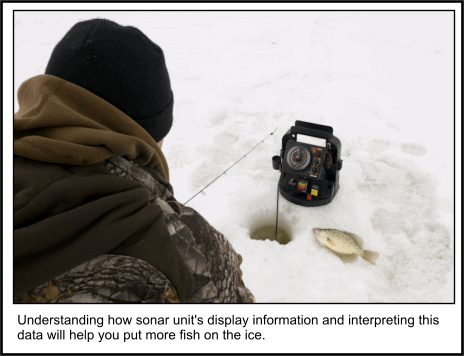|
 Ice
More Fish by Understanding Sonar Ice
More Fish by Understanding Sonar
By Tim Allard*
One of the easiest ways to increase your ice fishing success is
using a portable sonar unit, often called a fish-finder. A sonar
displays depth, your lure and if fish are beneath you. Yet, how much
intel you gather depends on your understanding of the unit's
operation, your ability to manipulate its settings, and how you
interpret the display. Whether you're a beginner, a sonar savant, or
somewhere in between, the following operation tips will help you
catch more fish and avoid some common mistakes.
 Don't
Get Fooled by Weeds Don't
Get Fooled by Weeds
Fishing weeds with a flasher under the ice is an acquired
skill. To inexperienced users weeds can accidentally be interpreted
as fish signals. One rule to follow is to look for movement. Weed
signals don't move up and down much but will sometimes flicker,
especially if there’s current. Of course, you're never 100% sure
until you jig the signals whether it's vegetation or fish. Most
flashers also have a low-power mode for shallow water. It reduces
the transducer's output so plant signals aren't displayed as strong,
resulting in a less cluttered screen.
Vegetation is easy to distinguish on a scrolling graph display. It
will look like weeds on the sonar screen, copying its underwater
profile, whether thin and sparse or thick like bushes. Any fish that
are inhabiting the vegetation will appear as a horizontal line
running through the greenery.

Hard Versus Soft Bottom
Differentiating between bottom types is another important
talent and can help you hone-in on prime fish habitat. Walleye and
lake trout will often ambush smaller fish against hard-bottom
structures, like humps and points. Soft-bottom spots appeal to
perch, crappie and sunfish that dine on the invertebrates inhabiting
this spongy zone. Transitions between hard and soft bottom areas
concentrate fish too, so comparing readings between different holes
is important.
When it comes to flashers a hard bottom causes a thin, strong signal
because rock reflects a powerful signal back to the transducer. A
soft bottom is displayed as a thicker band. This is because the
sound beam penetrates into the sticky bottom and returns a deeper
reading, although it also absorbs some of the sound energy and
therefore the lower sections of a soft bottom are displayed as weak
signals.
Scrolling chart displays show bottom the same way as open water. A
thick line means a hard bottom, and a soft bottom’s a thin line.
Rising Fish?
Sonars often display interested fish as "rising" from a
deep water to your lure. It’s common for fish to swim up to grab a
bait when you’re jigging it well off bottom. When this happens an
up-swimming fish is displayed as a strong signal the entire time.
However, weak signals that grow stronger mean another thing
entirely. This is caused when a fish moves in from the outside of
the sonar cone towards its center, which is often the case with
suspending species like crappie. A weak fish signal displayed 2 feet
below your bait may actually be close to the same depth as your
lure, but 2 feet off to the side. In this instance, as the fish
approaches your bait and the centre of the cone, the signal grows
stronger and the fish appears to swim up. For this reason, jig above
fish signals to reduce the chances of unintentionally positioning
the bait beneath the fish.
For similar reasons, flickers in the bottom signal or its trailing
edge on a flasher could be fish on the edges of the cone angle near
bottom, says Tom Zenanko, Sales and Marketing Manager with Vexilar,
Inc. Remember, unlike a moving boat, which results in a constantly
changing display, ice fishing is stationary, so flickers or colour
changes on bottom shouldn’t be taken lightly - walleye and perch
anglers take note.

Crank Gain to See Suspenders
A trick to get more information about what’s below is
increasing the gain when fishing suspenders, like perch and crappie.
This tactic relates to how a sonar displays fish on the edges of a
sonar cone. Turning up the gain will enhance the data shown from the
fringe of the electronic’s area of coverage. Increasing gain allows
you to see a fish that might be on the periphery of the sonar cone
but who’s signal is too weak to be displayed on a low gain setting.
Improving your sonar understanding makes you a more effective
angler. Ultimately, time on the ice and fishing different scenarios
is what counts, but heeding the above tips puts you ahead of others
not tuned into the power of portable sonar.
*Tim Allard of Ottawa, Ontario is a hard-water expert and
author-photographer of the newly released book, Ice Fishing: The
Ultimate Guide. For information visit:
www.helipress.com/product/ice-fishing-138.cfm.
Editors & Publishers
T.J. & Monique Quesnel
|
The
Ontario Fishing Network
E-Magazine is
published 12 times a year on or near the beginning of every month. Our
magazine is geared to any angler who enjoys fishing of any type in the
wonderfully diverse province of Ontario. Editorial Submissions: We welcome query letters,
but assume no responsibility for unsolicited materials. Subscriptions: Subscriptions are FREE of charge
and delivered via email.
You can subscribe
HERE: Privacy Policy: Unlike other publications We
NEVER make our subscribers list (your email address) available to any
other companies. Advertising: If you are interested in advertising
please email us. Circulation - 12,000 email subscribers
© 2010 Due North
Marketing / Ontario Fishing Network / T.J. Quesnel. All rights
reserved. Reproduction of any material without prior written
permission strictly prohibited. |
|